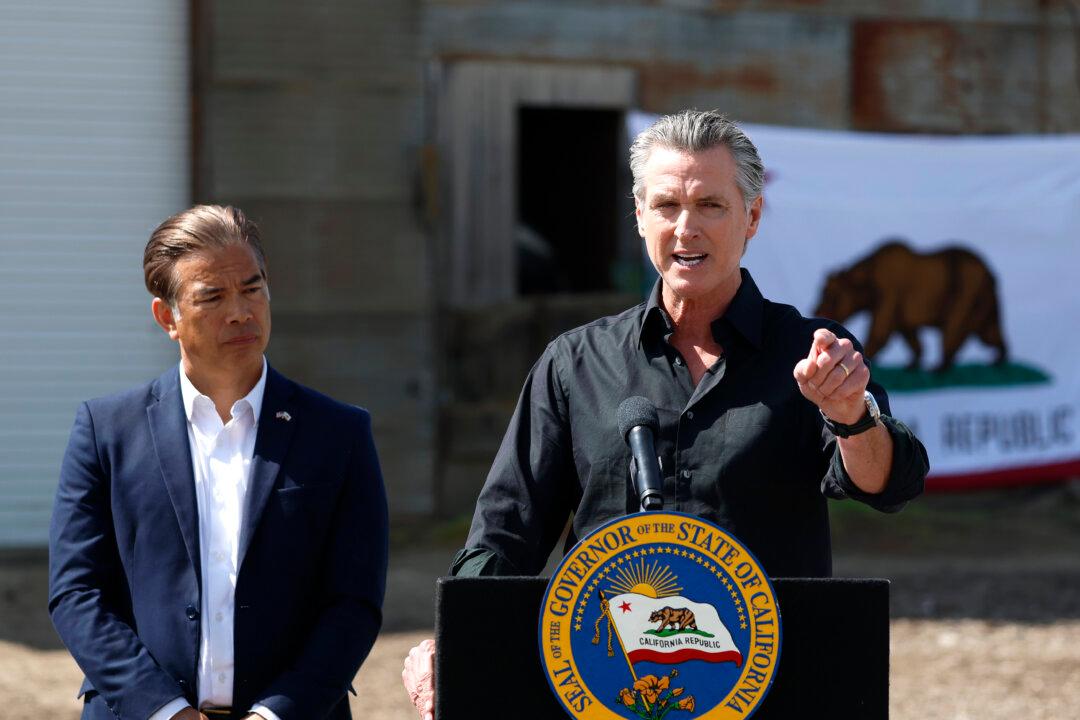More than 2 million homes in California are considered as being at high or extreme fire risks, according to industry analysts, and with insurers responding by deeming certain areas and properties uninsurable—and increasing premium costs for others—some homeowners say they are left with few options.

Increased fire risks are leading some insurance companies to raise premiums, and in some instances, to cancel policies or refuse renewals, according to experts.
As a result, some homeowners across the state are receiving letters informing them they are being dropped by their insurance companies.
Linda and Warren Ware moved to Mendocino County in 1972 where they raised a family and have owned several rental homes in the area for approximately five decades.
This year, the Ware’s insurance company dropped their coverage, citing fire risk.
“There is a brush score that the companies rely on to assess risk, and we scored a 10, the highest danger,” they told The Epoch Times.
Now they say they are stuck with what’s known as California’s FAIR plan, a last-resort insurer that provides insurance to those unable to find coverage in the traditional marketplace.
While the plan is offering fire insurance for two homes in Potter Valley, California, on the eastern edge of Mendocino County near the national forest—deemed too risky by others to insure—the Wares say the premiums are approximately three times the cost of their prior plan, with significantly less coverage.
“We’re paying approximately $18,000 for fire insurance this year to cover two dwellings,” they said. “At these costs, it’s like having a mortgage on the property.”

Things have changed dramatically in the last seven years, residents and realtors say with a steady succession of fires leading insurers to reconsider coverage.
Demand is down in fire-prone areas, as evidenced by listings and sales records, and for those willing to take on the risk, the costs are much higher due to the surge in premium prices.
“You have to factor it in to what you’re paying for the property, so it absolutely will be detrimental to home sales,” the Wares said.
Their story is not unique, with other families in Northern California reporting similar situations.
The couple has since moved from Georgetown, California—in El Dorado County—to Nevada, due to the loss of insurance and differences with political policies in the state, Reite said.
“Just about everybody’s insurance up here was dropped,” he said. “We moved the first part of last August—been gone about a year.”

Northern California represents the greatest area affected in terms of square miles and concentration of homes at risk, with all five of the highest percentages of danger coming from counties in the region, according to Verisk data.
Alpine County leads the state with 89 percent of homes in high and extreme wildfire risk categories, with Trinity’s 82 percent and Tuolumne’s 81 percent representing second and third, respectively.
Rural, northern regions are not the only areas of concern, as the exclusive enclave of Montecito in Santa Barbara County rates as one of the tougher areas to secure coverage, after fire insurance companies experienced significant losses when multi-million-dollar estates burned during past years, according to industry experts.
While Southern California has a smaller percentage of homes in peril, the number of housing units at risk is substantial, according to Verisk.
Los Angeles County’s 434,400 at risk homes rank as the highest in the state, with San Diego placing second with 252,500, and San Bernardino’s 112,700 rating third.
At issue is a series of wildfires that ravaged the state over the past seven years, and insurance problems arose in earnest after the Tubbs fire scorched Sonoma County in 2017—the most destructive in California’s history at the time.
“Since 2017, we’ve seen a dramatic increase in the number of homes, structures, and businesses burned,” Janet Ruiz, spokesperson for the Insurance Information Institute—an organization based in New York providing data and research to the industry—told The Epoch Times. “This really affected the bottom line of the insurers.”
More than 5,000 homes were lost in the Tubbs fire, and approximately 5 percent of those in Santa Rosa, California, were destroyed in the blaze, after more than 3,000 dwellings there burned to the ground, according to the California Department of Forestry and Fire. Twenty-two fatalities were reported.
The fire, which burned for 23 days, was responsible for $8.7 billion in insured damages, according to the insurance institute.
Also, accelerating insurance cancellations was the Camp fire that occurred in the Gold Country region of North-Eastern California in 2018, reportedly started by a Pacific Gas and Electricity transmission line, as the inferno claimed 85 lives and burned nearly 19,000 structures, including more than 14,000 residences, according to Cal Fire statistics.
Known as the worst wildfire in U.S. history—with $10 billion in insurance claims—according to the insurance institute, the Camp fire nearly leveled the town of Paradise, California.

Governance and policies pertaining to forest management are contributing to the increase in wildfires, according to Jim Nielsen, a former California state senator.
“Environmental policies for decades, federal and state, said don’t clean up the forest and wildlands,” he said in the Leaving California documentary. “Now we’re reaping the rewards of that...the fuel has grown out of control.”
While 2022 was a relatively quiet fire season, 772 homes were destroyed statewide.
But the years prior were historic, as five of the six largest wildfires in the state’s history burned in 2020, according to Cal Fire.
Winter storms this year have brought relief to drought-stricken areas, but the extra precipitation has created conditions conducive to burning during the dry season, according to a Cal Fire spokesperson.
“Residents should be mindful of extra vegetation and downed trees on their property,” the Cal Fire spokesperson told The Epoch Times. “Now is the time to clear areas around structures and mitigate fire dangers.”
High winds and snow caused many trees to fall, and with debris lying on the sides of roadways in many areas, they say this could provide another fuel source if not cleared before fire season.
“Wildfire risk hasn’t gone away because the drought has,” Ruiz, the spokesperson for the insurance institute said. “Where there’s fuel, there’s potential for fire.”
Premiums are on the rise due to more than just fire risk, with inflation, a shortage of contractors, and the cost of reinsurance— the coverage insurance companies carry to pay out losses—affecting prices, according to Ruiz.
Homeowners are not the only ones impacted, as documented by the Community Associations Institute—a Glendale, California based organization providing research and resources to apartment and condominium dwellers and homeowner’s associations.
A nationwide survey of community associations conducted in 2023 by the Foundation for Community Association Research, in support of the associations institute, found that more than 90 percent of respondents experienced an increase in insurance premium costs.
Cancellations and price increases taking place spontaneously mid-year are presenting budgeting challenges for organizations, according to Dawn Bauman—executive director of the foundation and senior vice president of the associations institute.
“Some community associations are being forced to take out loans to cover the cost of insurance,” she told The Epoch Times.
The spike in cost is so extreme, some condominium owners are being priced out of insurance, according to experts.
“One association saw their cost jump from $40,000 to $460,000 annually,” said Kimberly Lilley, director of business development at Southern California based Berg Insurance. “One association’s premium went from $20,000 a year to $930,000, so now they’re only getting $10 million in coverage when they need $50 million.”
Without full coverage, properties do not qualify for Fannie and Freddie Mae loans, which represent approximately 70 percent of loans, according to Lilley.
“They can’t get federally backed loans,” she told The Epoch Times. This leaves potential buyers and sellers “in a really difficult situation.”





